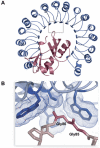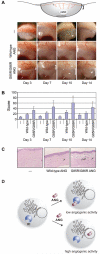Ribonuclease inhibitor regulates neovascularization by human angiogenin
- PMID: 19354288
- PMCID: PMC2677630
- DOI: 10.1021/bi9005094
Ribonuclease inhibitor regulates neovascularization by human angiogenin
Abstract
Human angiogenin (ANG) is a homologue of bovine pancreatic ribonuclease (RNase A) that induces neovascularization. ANG is the only human angiogenic factor that possesses ribonucleolytic activity. To stimulate blood vessel growth, ANG must be transported to the nucleus and must retain its catalytic activity. Like other mammalian homologues of RNase A, ANG forms a femtomolar complex with the cytosolic ribonuclease inhibitor protein (RI). To determine whether RI affects ANG-induced angiogenesis, we created G85R/G86R ANG, which possesses 10(6)-fold lower affinity for RI but retains wild-type ribonucleolytic activity. The neovascularization of rabbit corneas by G85R/G86R ANG was more pronounced and more rapid than by wild-type ANG. These findings provide the first direct evidence that RI serves to regulate the biological activity of ANG in vivo.
Figures


References
-
- Fett JW, Strydom DJ, Lobb RR, Alderman EM, Bethune JL, Riordan JF, Vallee BL. Isolation and characterization of angiogenin, an angiogenic protein from human carcinoma cells. Biochemistry. 1985;24:5480–5486. - PubMed
-
- Olson KA, Byers HR, Key ME, Fett JW. Prevention of human prostate tumor metastasis in athymic mice by antisense targeting of human angiogenin. Clin. Cancer Res. 2001;7:3598–3605. - PubMed
-
- Olson KA, Byers HR, Key ME, Fett JW. Inhibition of prostate carcinoma establishment and metastatic growth in mice by an antiangiogenin monoclonal antibody. Int. J. Cancer. 2002;98:923–929. - PubMed
-
- Raines RT. Ribonuclease A. Chem. Rev. 1998;98:1045–1065. - PubMed
-
- Pizzo E, D’Alessio G. The success of the RNase scaffold in the advance of biosciences and in evolution. Gene. 2007;406:8–12. - PubMed
Publication types
MeSH terms
Substances
Grants and funding
LinkOut - more resources
Full Text Sources
Other Literature Sources
Molecular Biology Databases
Miscellaneous

